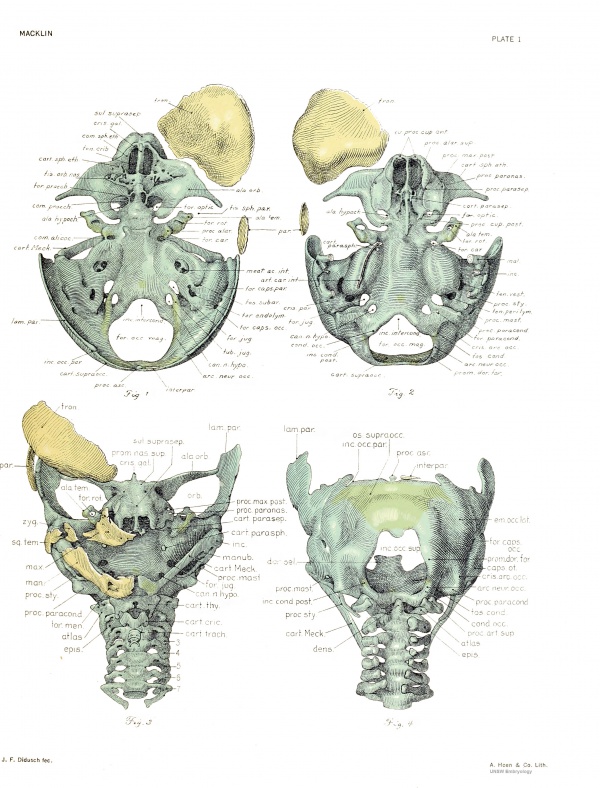Book - Contributions to Embryology Carnegie Institution No.48
All drawings were made by Mr. James F. Didusch according to geometric projection. With the exception of figure 7, which was made from a profile reconstruction, all figures were drawn from the original plaster-of-paris models made from human fetus No. 886 of the collection of the Carnegie Laboratory of Embryology. The number of the model from which each figure was drawn is given, together with the magnification.
Note - the magnifications refer to the original print versions, not the online images.
Plate 1
Note - the magnifications refer to the original print versions, not the online images.
Fig. 1. Chondrocranium from above with frontal and parietal bones on right side. The densest part of the frontal bone is inclosed by a dotted hne. The basal plate is not quite horizontal, the cranial end being a little the closer to the eye of the observer. Model 1. X6.25.
Fig, 2. Chrondrocranium from below with cartilaginous branchial arch skeleton extirpated. Frontal and parietal bones are shown on right side. The basal plate is not quite horizontal, the caudal end being a httle the closer to the eye of the observer. The view is directly into the anterior nares. Model 1. X6.25.
Fig. 3. Skull from front, showing membrane bones on right side. Face is seen in frank view. The cervical vertebrae and cartilaginous branchial arch skeleton are also seen. Model 1. X6.25.
Fig. 4. Skull from back, giving a frank view of the foramen oocipitale magnum. The cervical vertebrtae are seen, their arches beiag as yet unclosed dorsaUy. Note the alignment of the hemiarch tips with the dorsal foraminal prominences, representing the extremities of the hemiarches of the occipital vertebra. The right half of the interparietal bone is seen. Model 1. X6.25.
Plate 2
Fig. 5. Skull from right side, showing membrane bones. The cervical vertebrae and cartilaginous branchial arch skeleton are included. Only the right half of the skull is shown. Model 1. X6.25.
Fig. 6. Left half of chondrocranium, cervical vertebrae, and cartilaginous branchial arch skeleton as seen from left side. Model 1. X6.25.
Fig. 7. Profiles of external form of head, brain and upper end of spinal cord, and skull, in their normal relation to one another, as seen from the right side. Drawn from a profile reconstruction. Xl-9.
Fig. 8. Condensed mesenchyme enveloping the vomer, seen from front, side, and above. The anterior extremities of the vomer are indicated. The gutter in the center is for the lower edge of the nasal septum. There is a slight amount of lateral curvature. The cut edges of the mesenchyme are indicated. Model 22. X12.5.
Fig. 9. Two halves of the vomer from the same point of view as that of figure 8. They are very slender spicules of bone lying along the lower border of the nasal septum. Model 21. X12.5.
Fig. 10. Median stem of skull as seen from right side. It consists of the basal plate behind and the interorbital and nasal septa in front, forming ai- "btuse angle at the body of the sphenoid. The adjoining exoccipital cartilage is shown in part. Junctions with cartilage lying laterally are shown. Model 4. X12.5.
Fig. 11. Right half of basal plate and parts of upper two cervical vertebrae, sectioned in the mid-sagittal plane. The cut surface is seen in frank view. Shows the preossification center for the basioccipital, the notochord, the pharyngeal bursa with a little of the epithelium of the roof of the pharynx, the temporal wing, dorsum seUae and a portion of the exoccipital. Model 8. X12.5.
Fig. 12. Left cartilage of Jacobson from left side with neighboring septum. Models 2 and 25. Xl2,5.
Fig. 13. CartUages of Jacobson from below in relation to nasal septum. Models 2 and 25. X12.5.
Content to be added----
| Historic Disclaimer - information about historic embryology pages |
|---|
| Pages where the terms "Historic" (textbooks, papers, people, recommendations) appear on this site, and sections within pages where this disclaimer appears, indicate that the content and scientific understanding are specific to the time of publication. This means that while some scientific descriptions are still accurate, the terminology and interpretation of the developmental mechanisms reflect the understanding at the time of original publication and those of the preceding periods, these terms, interpretations and recommendations may not reflect our current scientific understanding. (More? Embryology History | Historic Embryology Papers) |
Glossary Links
- Glossary: A | B | C | D | E | F | G | H | I | J | K | L | M | N | O | P | Q | R | S | T | U | V | W | X | Y | Z | Numbers | Symbols | Term Link
Cite this page: Hill, M.A. (2024, April 19) Embryology Book - Contributions to Embryology Carnegie Institution No.48. Retrieved from https://embryology.med.unsw.edu.au/embryology/index.php/Book_-_Contributions_to_Embryology_Carnegie_Institution_No.48
- © Dr Mark Hill 2024, UNSW Embryology ISBN: 978 0 7334 2609 4 - UNSW CRICOS Provider Code No. 00098G


